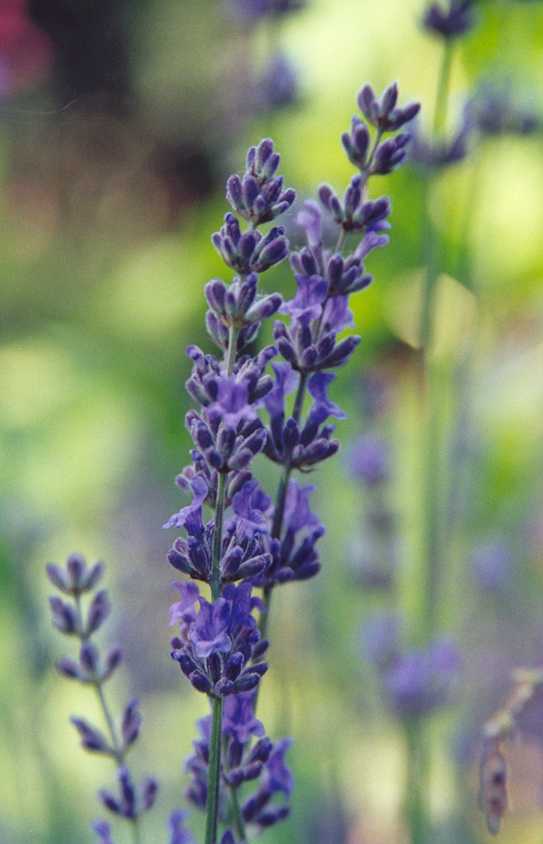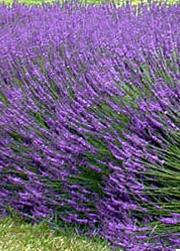
More information:
Medical Lavender
www.pioneerthinking.com
 COOKING WITH LAVENDER
The stems and leaves of lavender can be used in dishes in place of rosemary in most recipes. Just place your favorite fruit on the stems and grill. For soothing lavender tea: brew 1 - 2 tsp whole herb per cup of hot water.
HISTORY OF LAVENDER
Lavender has long been a favorite. The use of lavender is almost as old the history of man. As an herb and perfume, lavender has been appreciated for over 2,500 years. It is a native to the eastern Mediterranean Region and was commonly used for its scent by Greeks and Romans. The name derives from the Latin word for bathing. From southern Europe, gardening with lavender spread to England, Ireland, America, Canada, New Zealand, South Africa, and Australia. (More on Video)
MEDICAL USES
Studies have reported that lavender may be beneficial in a variety of conditions, including insomnia, hair loss, anxiety, stress, diabetes, postoperative pain, and as an antibacterial and antiviral agent. The essential oil is concentrated in the flower blooms. To inhale: 2 - 4 drops in 2 - 3 cups of boiling water. Inhale vapors for headache, depression, or insomnia.
LAVENDER AS BUG REPELLENT
To repel mosquitoes take some lavender flowers and rub it on your wrists and neck or anywhere you have exposed skin. Many herbs have some insect repellent qualities, but few smell as fragrant as lavender.
|
A flower, a herb, a color, a scent--
LAVENDER is each of these. Easy to grow and easy to appreciate, lavender is well worth growing as a flower and an aromatic herb.
Lavender needs good drainage
A perennial, lavender grows from 1 to 3 feet tall, depending on the variety. It needs at least six hours of direct sun each day, preferably more. Lavender is a shrubby plant originally from the Mediterranean region that will grow in hardiness zones 5 through 10. More on lavender videos.
It can grow in fair or poor soils, slightly alkaline to neutral is best. Lavender plants require well-drained soil, soggy soils are deadly. If drainage is a problem, grow lavender in a large container, a raised bed, or on a 10 inch high ridge or mound made from a mixture of one-third soil and two-thirds sand. Lavender needs little or no fertilization, and except for new plants, should be watered less often than most flowers.
Lavender is relatively free of diseases, and most insects will not feed on it because of its strong aroma. It does attract beneficial insects such as bees. The plant should be allowed enough room for good air circulation to prevent mold from becoming a problem. Lavender doubles in size by its second year and reaches maximum size by the third year.
Lavender has purple blooms in midsummer. Old flower heads should be pruned to encourage fresh growth. Prune one-third off the top of the clump to within two inches of the woody part.
The blooms range from lavender-hued gray to a vibrant royal purple. The flowers themselves are small, sometimes bud-like but open and full on others, and grow in clusters on the ends of spiky stems. There are also less common species with blooms in white, pink, and a yellow-green.
Types of Lavender
There are more than 20 species of lavender though the most common one grown in the garden is known as "English Lavender" (Lavendula angustifolia). Some varieties of lavender can be grown from seeds (especially variety "Munster"), or pots of live plants can be purchased from garden centers in the spring. Favorite varieties include "Grosso", "Provence", "Royal Purple", "Gray Lady", and "Hidcote".
Other species of Lavender include: L. Stoechas "Spanish Lavender" is distinguishable by small, purple butterfly-like bracts on the top of pinecone shaped blossom. It grows 18 inches high in zones 8 to 11 and is a good choice in warmer humid climates. L. dententa "French Lavender" is less colorful and fragrant than "English Lavender". It has serrated leaves, grows to a height of 36 inches, and is a perennial in zones 8 - 11.
Not all types are readily available, but may be found though researching mail order web sites and nursery catalogs. Foliage typically ranges from dusty green to silvery gray, and a few species have bright chartreuse leaves.
Propagating Lavender
Lavender's older stems are woody, and the plant does not divide as easily as many perennials. If moving is necessary, lift the plant in spring just after new growth has started and replant immediately. The plant can be propagated by layering.
Layering requires one of the more supple side stems to be carefully bent to the ground. Where the stem is touching the ground, dig a one inch deep trench. Remove all leaves except at the tip of the stem. Lay the stem in the trench and mound two inches of soil over it. Anchor the stem with a weight, such as a brick placed on top of the mound. The tip of the stem should be left exposed to grow. Eventually, the buried portion will take root and can be used to start a new plant.
Probably the most common way of propagation is by taking cuttings. Cut healthy three to four inch stems and remove leaves from the lower two-thirds. Dip the tips in rooting hormone, and place two inches deep in a pot with damp sand or perlite. Place in a sunny indoor spot and keep the rooting medium moist but not soggy. When you see new growth, roots have formed and it can be moved to a pot with potting mix. Plant outside a month or two later when it has grown enough to have substantial roots.
Making Lavender Potpourris
To save lavender for potpourris, cut the stems when they are blooming, tie them in small bundles and hang them upside down indoors to dry for several weeks. More on Videos.
Scientific Name:
Lavendula
Please search here and click on Google ads to support this site.



Pesticide

gardening in Australia, gardening in new zealand, gardening in Canada, gardening in Britian..............................................
|